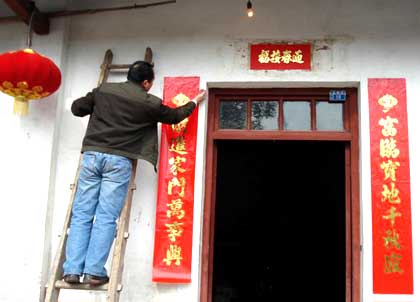Source: chinaculture.org
01-18-2008 09:26
 |
Lunar New Year's Eve, the last day of the old year, is one of China's most important traditional holidays. Homes are spotless in and out, doors and windows are decorated with brand new Spring Festival couplets, New Year's pictures, hangings, and images of the Door God, and everyone dresses up in new holiday clothes that are decorated with lucky patterns and auspicious colors.
To the Chinese, New Year's Eve dinner is more than just enjoying a grand feast. On this day, all Chinese all over the world, no matter how far away from home they are or how busy at work, will be home for dinner.
The elaborate dinner is laden with auspicious food. The names of the dishes express the wish for good luck in the coming year. Most dishes are prepared with uncut or whole ingredients to ensure integrity and perfection. The use of knives is considered unlucky as this could sever the family's good fortune.
The sumptuous New Year dinners are prepared with the most delicate culinary artistic skill and good wishes to welcome relatives and friends with a choice of festive treats. Today, a growing number of Chinese choose to have reunion dinners at restaurants or invite cooks home to make dinners for them.
Legend has it that long ago during the age of great floods, there was a vicious monster named Nian, which means year. Whenever the thirtieth day of the last lunar month arrived, this monster would rise up out of the sea, killing people and wrecking havoc in their fields and gardens. The people would bar their doors before dark and sit up all night, coming out the next day to greet their neighbors and congratulate them on surviving. Once on the last night of the last month, Nian suddenly burst into a small village, devouring almost all the people who lived there. Only two families emerged unscathed. The first, a newlywed couple, avoided harm because their celebratory red wedding clothes resembled fire to the monster, so it did not dare to approach them. The other family was unharmed because their children were playing outside setting off noisy firecrackers, and the noise scared the monster away. Ever since, people have worn red clothes, set off firecrackers, and put up red decorations on New Year's Eve to keep the vicious monster Nian away. Later, according to the legend, the Emperor Star deity struck Nian down with a flaming orb and bound him to a stone column. Only then was there peace in the world. Ever since, people stay up all night and burn incense on New Year's Eve, entreating the Emperor Star to descend to earth and protect them.
Every year on New Year's Eve, people paste up images of the Door God on their doors. The Door God, or guardian of the threshold, is a very old deity. In its earliest incarnation, it was embodied in the door itself. The Door God was first portrayed in human form during the Han Dynasty, first as the warrior Cheng Qing, and later as Jing Ke. The door gods of the Northern and Southern Dynasties were named Shen Tu and Yu Lei. During the Tang Dynasty, two great generals named Qin Shubao and Yuchi Jingde were in charge of protecting the officials of the imperial palace. Emperor Tang Taizong (Li Shimin) felt that the generals were working too hard, so he ordered their portraits to be painted and hung beside the palace door to assist them. The two generals thus became associated with the ancient guardians of the threshold, and have been known as door gods ever since. During the Five Dynasties Period, Zhong Kui became the new door god. The Song Dynasty saw the further development of existing guardians and protectors. In addition to door gods, images of the gods of Blessings, Prosperity, and Longevity, as well as the Ten Thousand Deities and the Three-Treasures Buddha, are often hung in living rooms and bedrooms. These guardian deities were thought to protect the household from evil influences and repel demons.
New Year pictures, as their name implies, are made especially to celebrate the Lunar New Year holiday. With the coming of Spring Festival, these pictures appear in households throughout the nation, their bold outlines and vibrant colors adding to the excitement of the holiday season. New Year's pictures are an ancient Chinese folk art, reflecting the simple and thrifty customs and beliefs of the common people, and embodying their hopes for the future. New Year pictures, like Spring Festival couplets, trace their origins to China's ancient door gods. After a certain point, however, these pictures were no longer limited to depicting the various protective deities, and became increasingly rich and colorful. Among the common subjects of New Year pictures are "A Surplus Every Year," "Peace Year After Year," "Blessings from Heaven," "An Abundance of Grain," "Flourishing Livestock," and "Spring Comes with Good Fortune."
